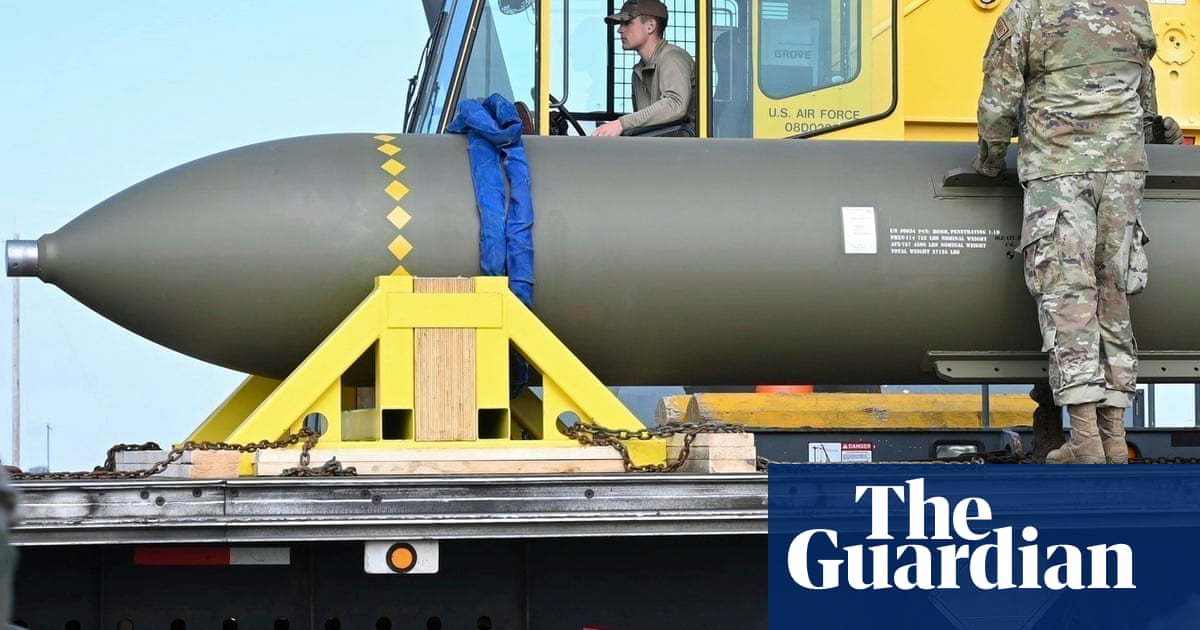Donald Trump has suggested to defense officials it would make sense for the US to launch strikes against Iran only if the so-called “bunker buster” bomb was guaranteed to destroy the criticaluranium enrichment facility at Fordow, according to people familiar with the deliberations.
Trump was told that dropping the GBU-57s, a 13.6-tonne (30,000lb) bomb would effectively eliminate Fordow but he does not appear to be fully convinced, the people said, and has held off authorizing strikes as he also awaits the possibility that the threat of US involvement would leadIranto talks.
The effectiveness of GBU-57s has been a topic of deep contention at the Pentagon since the start of Trump’s term, according to two defense officials who were briefed that perhaps only a tactical nuclear weapon could be capable of destroying Fordow because of how deeply it is buried.
Trump is not considering using a tactical nuclear weapon on Fordow and the possibility was not briefed by defense secretary Pete Hegseth and the chairman of the joint chiefs of staff Gen Dan Caine in meetings in the White House situation room, two people familiar with the matter said.
But the defense officials who received the briefing were told that using conventional bombs, even as part of a wider strike package of several GBU-57s, would not penetrate deep enough underground and that it would only do enough damage to collapse tunnels and bury it under rubble.
Those in the briefing heard that completely destroying Fordow, which Israeli intelligence estimates to go down as far as 300ft (90 metres), would require the US to soften the ground with conventional bombs and then ultimately drop a tactical nuclear bomb from a B2 bomber to wipe out the entire facility, a scenario Trump is not considering.
The assessments were made by the Defense Threat Reduction Agency (DTRA), a component of the defense department that tested the GBU-57, as it reviewed the limitations of US military ordinance against a number of underground facilities.
The situation underscores the complex nature of such a strike and what success would entail: dropping GBU-57s would likely set back Iran’s ability to obtain weapons-grade uranium for up to a few years, but not end the programme completely.
Spokespeople for the White House and the Pentagon did not immediately respond to requests for comment.
Taking Fordow offline – either diplomatically or militarily – is seen as central to prevent Iran from acquiring nuclear weapons after the International Atomic Energy Agency (IAEA) found the site hadenriched uranium to 83.7%– close to the 90% needed for nuclear weapons.
Any effort to destroy Fordow, would require US involvement because Israel does not possess the ordnance to strike a facility that deep or the planes to carry them.
The difficulty with using the GBU-57 to target Fordow, according to the two officials familiar with the DTRA briefing, lies in part with the characteristics of the facility which is buried inside a mountain – and the fact that the bomb has never been used in a comparable situation before.
“It would not be a one and done,” a former Dtra deputy director, retired Maj Gen Randy Manner, said of the GBU-57’s limitations, adding that Fordow could be quickly rebuilt. “It might set the program back six months to a year. It sounds good for TV but it’s not real.”
The bomb is commonly known as a “bunker buster” because it was designed to destroy underground bunkers, but it can be carried only by a B2 bomber that has air superiority and requires a solid GPS signal to lock in on its target.
While Israel has said it has established air superiority over Iran, a successful strike would still require any GPS jammers and other defenses to be taken out in advance, and for the the GBU-57 to penetrate deep enough into the ground to neutralize the facility.
Iran built the nuclear enrichment facility at Fordow underground to protect it from the threat of aerial attacks. In 1981, Israel bombed a nuclear facility near Baghdad that was located above ground in order to stop Iraq developing nuclear weapons.
In recent years, Israel has devised a variety of plans to destroy Fordow without the help of the United States. In one instance, Israel proposed loading helicopters with commandos who could fight their way into the facility and blow it up – an option that Trump has dismissed, according to people familiar with the matter.
